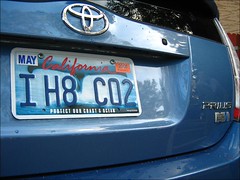 Turns out, a witty license plate for a gasoline powered car isn't enough. We needed to act before nature's balance tipped. We didn't. Image by 37 °C via Flickr
Turns out, a witty license plate for a gasoline powered car isn't enough. We needed to act before nature's balance tipped. We didn't. Image by 37 °C via Flickr
Sub-Arctic timebomb: warming speeds CO2 release from soil
An increase of just 1.0 degree Celsius (1.8 degrees Fahrenheit) over current average temperatures would more than double the CO2 escaping from the peatlands.
Northern peatlands contain one-third of the planet's soil-bound organic carbon, the equivalent of half of all the CO2 in the atmosphere.
Peat is an accumulation of partially decayed vegetation found in wetlands or peatlands, which cover between two and three percent of the global land mass. While present in all climate zones, the vast majority of peatlands are found in sub-Arctic regions.
A team of European researchers led by Ellen Dorrepaal of the University of Amsterdam artificially warmed natural peatlands in Abisko, in northern Sweden, by 1.0 C over a period of eight years.
The experimental plots exhaled and extra 60 percent of CO2 in Spring and 52 percent in Summer over the entire period, reported the study, published in the British journal Nature.
"Climate warming therefore accelerates respiration of the extensive, subsurface carbon reservoir in peatlands to a much larger extent than previously thought," the authors conclude.
The findings highlight the extreme sensitivity of northern peatland carbon reservoirs to climate change, and the danger of a self-reinforcing "positive feedback" in which the CO2 released adds to global warming.
And unlike the boreal forests in Canada, Russia and Northern Europe, very little of the extra carbon was absorbed by additional vegetation spurred by the warmer temperatures.
The researchers warn that annual surplus CO2 released by peatlands with a 1.0 C increase -- between 38 and 100 million tonnes -- could cancel out the European Union objective of slashing greenhouse gas emissions by 92 million tonnes per year.
In another study released last month, the Global Carbon Project based in Australia found that the amount of carbon stored in the Arctic and boreal regions of the world is some 1.5 trillion tonnes, more than double previous estimates.
This is it, folks -- the moment when the long, long, ricketyricketycreak ascent up one side of the roller coaster just eases and you stand poised--just for a moment--and see that first tremendous drop ahead of you and you realize that there's no getting off the ride now.
We've pumped enough greenhouse gases into the atmosphere to destabilize the climate to the point where now, we don't have to do anything at all --- we're just along for the ride, and it doesn't stop until a new equilibrium is reached, probably in a much, much hotter and less benign climate.
Congratulations to all the climate change deniers, you succeeded in your mission of preventing any meaningful action until it was too late.

![Reblog this post [with Zemanta]](http://img.zemanta.com/reblog_e.png?x-id=1215c831-ce98-402b-aab8-8f52ff9af006)


![Reblog this post [with Zemanta]](http://img.zemanta.com/reblog_e.png?x-id=821daeaa-6735-4430-9995-04f2bc59a9cd)



